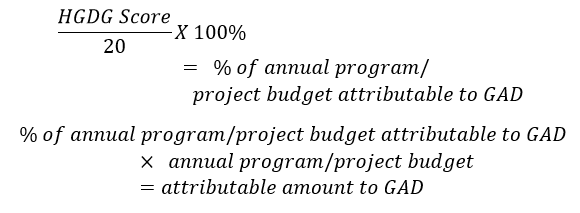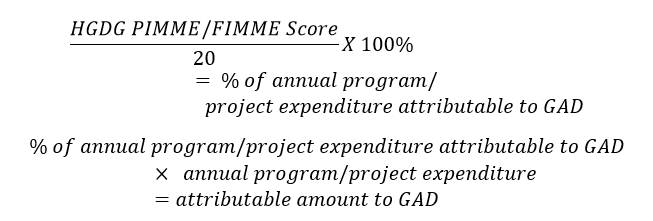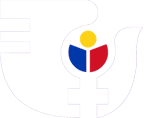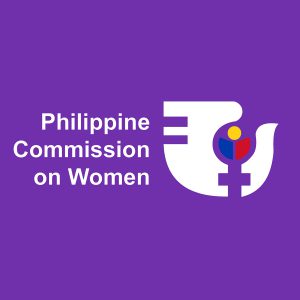PCW-DBM-NEDA Joint Memorandum Circular 2022-01: Revised Guidelines for the Preparation of Annual Gender and Development (GAD) Plans and Budgets and GAD Accomplishment Reports to Implement the Magna Carta of Women
1.0 PURPOSE
To prescribe the revised guidelines and procedures for the formulation, submission, implementation, monitoring and evaluation, including accounting of results of annual GAD plans and budgets (GPBs) and GAD accomplishment reports (GAD ARs) of national government agencies1 and Bangsamoro Autonomous Region in Muslim Mindanao (BARMM) line agencies and SUCs.
2.0 LEGAL FRAMEWORK
2.1 Section 11 and 14 of Article II of the 1987 Philippine Constitution provides that: The State values the dignity of every human person and guarantees full respect for human rights, and recognizes the fundamental equality of women and men before the law.
2.2 The Philippines also subscribes to the United Nations (UN) Convention on the Elimination of All Forms of Discrimination against Women (CEDAW), the Beijing Platform for Action (BPfA), the Sustainable Development Goals (SDGs) 2015-2030, and other similar international treaties and commitments.
2.3 Republic Act No. 9710 or the Magna Carta of Women (MCW), a comprehensive human rights law, embodies this policy as it promotes women empowerment, calls for equal opportunities for women and men, and ensures equal access to resources and to development results and outcome in the Philippines.
2.4 Pursuant to the MCW and the General Appropriations Act (GAA), all government departments, including their attached agencies, offices, bureaus; state universities and colleges (SUCs); government-owned and controlled corporations (GOCCs); local government units (LGUs); and other government instrumentalities shall formulate their annual GPBs within the context of their mandates to mainstream GAD perspectives in their policies, plans, and programs/ activities/projects (PAPs).
2.5 Executive Order No. 5, s. 2016, “Approving and Adopting the Twenty-Five-Year Long Term Vision Entitled AmBisyon Natin 2040 as Guide for Development Planning,” provides that all plans of government departments, offices and instrumentalities, including GOCCs and LGUs, shall be consistent with AmBisyon Natin 2040.
3.0 GENERAL GUIDELINES ON GAD PLANNING AND BUDGETING
3.1 The formulation of the annual GPB shall be guided by the desired outcomes and goals embodied in the Magna Carta of Women and its Implementing Rules and Regulations (MCW-IRR)2, the PPGD, development and sectoral plans for gender equality and women’s empowerment (GEWE), other relevant laws, as well as the UN CEDAW, BPfA, SDGs, and other international treaties and commitments.
3.2 GAD planning and budgeting shall be conducted annually as an integral part of all programming and budgeting exercises of agencies. The cost of implementing the programs, activities and projects (PAPs) in the GPB shall be part of the agency budget. The PAPs in the GPB shall also form part of the annual Work and Financial Plan (WFP) of concerned offices or units of the agency.
3.3 Mainstreaming gender perspectives in agency PAPs to attain the desired outcomes for GAD shall be a priority in GAD planning and budgeting. Using the GAD budget for gender mainstreaming is a way for agencies to influence the entire agency’s programs, plans and budgets. Thus, the utilization and outcome of the GAD budget shall be annually monitored and evaluated in terms of its efforts in influencing the gender-responsive implementation of the entire agency program, plan and budget.
3.4 The GAD budget, which is the cost of implementing the GAD plan, shall form part of, and is not in addition to the agency’s approved annual budget. As provided under the Magna Carta of Women, “the cost of implementing GAD programs shall be the agency’s or the local government unit’s GAD budget which shall be at least five percent (5%) of the agency’s… total budget appropriations.”
3.5 The agency GAD Focal Point Systems (GFPS) shall take the lead in mainstreaming gender in the agency PAPs. As such, they shall coordinate the preparation of the agency GPB, monitor its implementation and report on the results through the GAD AR. They shall provide technical assistance on gender mainstreaming to offices or units within their agency.
3.6 The GAD PAPs of lower constituent units (i.e., regional, district and field offices) shall be integrated in the agency-consolidated GPB. (For example, in the case of the Department of Health (DOH), the GAD issues and corresponding PAPs of retained hospitals and treatment and rehabilitation centers shall be integrated in the DOH consolidated GPB). This shall also apply to GOCCs and SUCs with branches/campuses.
3.7 The determination of compliance to the 5% GAD budget shall be by agency and not by constituent unit. Thus, the budget of the regional or a constituent unit may not necessarily reach 5% of its total annual budget allocation or expenditure, but the central office shall ensure that the agency as whole will meet the minimum 5% GAD budget based on the agency’s total budget appropriation.
4.0 ESSENTIAL ELEMENTS IN GAD PLANNING AND BUDGETING
The following essential elements in GAD planning and budgeting shall guide agencies to effectively plan and implement their sectoral programs on GAD. If these are not present or need to be strengthened, agencies shall include them in their GPBs.
4.1 Creation and/or Strengthening of the GAD Focal Point System (GFPS): As required under Section 36(b) of the MCW, all agencies shall establish or strengthen their GAD Focal Point System (GFPS) to catalyze and accelerate gender mainstreaming within the agency. The creation and strengthening of the GFPS shall be in accordance with the PCW Memorandum Circular 2011-01 or the “Guidelines for the Creation, Strengthening and Institutionalization of the Gender and Development (GAD) Focal Point System.
4.2 Capability Building on GAD: A clear understanding and appreciation of gender and development is a prerequisite for GAD planning and budgeting. Agencies are required to regularly undertake orientations and capacity development activities on GAD, including GAD-related laws and commitments for their employees. Trainings shall include, but not be limited to gender sensitivity, gender mainstreaming, gender analysis and gender-responsive planning and budgeting.
4.3 Conduct of Gender Audit: Gender audit is an examination of the agency’s level of gender mainstreaming or extent of the gender-responsiveness of its policies, programs and projects, the level of gender awareness and competence of its personnel and the presence or absence of enabling mechanisms that support gender mainstreaming. The result of the gender audit could be a basis of capacity development programs that must be implemented and in enhancing the gender-responsiveness of agency policies and PAPs.
4.4 Institutionalizing GAD Database/Sex-disaggregated Data: The agency shall generate and analyze GAD information to include gender statistics and sex-disaggregated data as inputs or bases for planning, budgeting, programming, and policy formulation.
5.0 FORMULATING THE GAD PLAN
5.1 Agencies shall formulate their GAD Agenda3, which is their strategic framework and strategic plan on gender mainstreaming and achieving women’s empowerment and gender equality. The GAD Agenda shall serve as the agency’s reference in developing the annual GPB, particularly in identifying programs, activities, and projects to be undertaken to achieve the GAD goals and outcomes; and provide the monitoring and evaluation (M&E) framework for assessing GAD results that shall be the basis for strengthening the mainstreaming of GAD perspective in the agency’s operations and programs.
5.2 Based on the GAD agenda, the agency shall identify the GAD mandates it will implement, as well as priority gender issues to be addressed within the GAD Agenda’s timeframe. GAD mandates and gender issues may be client-focused or organization-focused. Client-focused GAD mandate or gender issue refers to those that pertain to the unequal status of women and men stakeholders of the agency including the extent of their disparity over benefits from and contribution to a policy/program and/or project of the agency. On the other hand, an organization-focused GAD mandate or gender issue points to the gap/s in the capacity of the organization to integrate a gender dimension in its programs, systems or structure.
5.3 Based on the GAD mandates and/or priority gender issues, the agency shall set the annual GAD results or outcomes that it intends to achieve, as well as the GAD programs, activities and projects (PAPs) that the agency shall develop and implement. It is possible that the GAD result or outcome could not be realized in one planning period. Thus, the agency may plan related GAD activities to be implemented over several planning periods until the desired outcome is achieved.
5.4 Agencies shall administer the enhanced Gender Mainstreaming Evaluation Framework (GMEF) tool to periodically assess the level of their gender mainstreaming efforts. The agency shall also assess the gender responsiveness of their major programs and projects4 using the Harmonized Gender and Development Guidelines (HGDG) tool. The results of the GMEF and the HGDG assessment will guide the agency in identifying areas for continued improvement and for attributing a portion of or the whole budget of the program or project to GAD.
5.5 For the members of the National Steering Committee on Women, Peace and Security (NCSWPS) and agencies that implement PAPs in conflict-/post-conflict affected areas, the preparation of GPBs and GAD ARs shall also be guided by the PCW-OPAPP Joint Circular 2014-01 on the integration of women, peace and security PAPs in the GPB.
Similarly, member agencies of other inter-agency bodies on GAD [e.g., the Inter-Agency Council on Violence Against Women and Their Children (IACVAWC), the Inter-Agency Council Against Trafficking (IACAT), the National Implementation Team (NIT) of the Responsible Parenthood and Reproductive Health Law (RPRH law), and the Inter-Agency Oversight Committee on the Safe Spaces Act (IAOCSSA) may also include in the GPB their commitment/s under these inter-agency bodies’ plans.
5.6 After gathering the data required above, the agency shall fill-out the GPB and GAD AR forms and encode the same in the Gender Mainstreaming Monitoring System (GMMS)5 for submission to PCW. Annex A provides for the Guide in Completing the GAD Plan and Budget Template.
6.0 ALLOCATION AND UTILIZATION OF THE GAD BUDGET
6.1 At least five percent (5%) of the total agency budget appropriation authorized under the annual GAA shall be allocated/attributed and utilized to fund GAD PAPs. Agencies should also ensure that the GAD plan is integrated in their regular activities. The GAD budget shall be drawn from the agency’s maintenance and other operating expenses (MOOE), capital outlay (CO), and personnel services (PS). (Note: The total agency budget appropriation should be adjusted based on the actual funds released, as basis of the GAD AR).
6.2 For GOCCs, the GAD budget shall be drawn from their corporate operating budget (COB). However, budget included in the COB that do not entail actual cash disbursements but only serve as entries in the accounting books, may be excluded in the computation of the minimum 5% GAD budget. The concerned GOCC shall submit to PCW the necessary documents as basis for the exclusion (e.g. interest expenses, debt servicing, etc.).
6.3 Attributing agency major programs or projects to the GAD budget.
6.3.1 Attribution to the GAD budget of the whole or a portion of the budget of an agency’s major programs or projects is a means toward gradually increasing the gender responsiveness of government programs and projects.
6.3.2 An agency may attribute a portion or the whole budget for the year of major programs/project during the GAD planning and budgeting phase, by subjecting the program documents to gender analysis using the appropriate HGDG project identification and design checklist (HGDG boxes 9-15, 18-23), the funding facilities checklist (HGDG Box F1) or the generic checklist (HGDG box 7a). The results of the HGDG assessment together with the supporting documents (e.g., project proposal/brief) shall be attached to the GPB submission. If the agency is not yet trained on the use of the tool, it may include said training in its GPB and may seek the assistance of an expert on gender analysis using the HGDG.
6.3.3 The use of the HGDG will yield a maximum score of 20 points for each program or project.
| HGDG Score | Description |
| 0 – 3.9 | GAD is invisible in the program/project |
| 4 – 7.9 | The program/project has promising GAD prospects |
| 8 – 14.9 | The program/project is gender-sensitive |
| 15-20 | The program/project is gender-responsive |
The percentage score of the HGDG assessment shall correspond to the percentage of the budget of the agency’s existing and proposed major program/project that may be attributed to the GAD budget. The formula shall be as follows:

For example, Program A has an annual budget of Php50 million and the design of the program was assessed using the generic HGDG checklist (box 7a). The HGDG score of Program A was 16.5 points over 20 points. The computation of the GAD budget shall be as follows:

Thus, the budget of Program A that may be attributed to GAD is Php 41, 250,000.00.
Programs/projects with HGDG scores below 4.0 shall not be eligible for budget attribution. Agencies are, nonetheless, encouraged to identify direct GAD activities to enhance the gender-responsiveness of the program and its design based on the result of the HGDG assessment.
6.3.4 During the preparation of its GAD AR, the agency will administer the HGDG using the Project Implementation and Management, and Monitoring and Evaluation (PIMME) checklist (HGDG Boxes 16 and 17) or the Facility Implementation, Management, and Monitoring and Evaluation (FIMME) checklist (HGDG Box F2) based on the project’s annual accomplishment report to determine the extent that the targeted HGDG score is attained. This score will be the basis in determining actual expenditure that can be attributed to GAD following the formula below:

Programs/projects with HGDG PIMME scores below 4.0 shall not be eligible for budget attribution.
6.4 Pursuant to Section 37A.2 of the MCW-IRR, NGA and other government instrumentalities shall ensure that five to thirty percent (5-30%) of funds received from ODA and multi-lateral agencies are in support of gender-responsive programs and projects.
7.0 SUBMISSION, REVIEW AND ENDORSEMENT OF AGENCY GAD PLANS AND BUDGETS
7.1 Submission, review and endorsement of all GPBs and GAD ARs shall be done through the GMMS. Agencies shall create or update their user account/s in the GMMS for the online submission of GPBs and GAD ARs by downloading and submitting to PCW the filled-out GMMS registration form.
7.2 PCW shall review GPBs submitted within the prescribed period as provided in the annual GAD budget call6 and inform the agency of its comments or action on GAD plans within the review period stated in the annual GAD budget call. The agency shall respond within the period prescribed by the PCW if there are revisions to be made, or if there are questions about the submission. The PCW shall inform the agency of the status of its GPB endorsement or non-endorsement upon receipt of the revised GPB, or before the end of the review period, whichever comes first.
7.3 PCW shall endorse a GPB, if and only if:
7.3.1 the GAD budget meets the minimum five percent (5%) allocation, and
7.3.2 the GPB reflecting PCW’s requested revisions, additional information or responses to the questions if any), has been received within the prescribed period and deemed sufficient by PCW.
7.4 Agencies shall print the endorsed GPB for signature of their agency head or his/her authorized representative.
7.5 Once the GAA has been approved and there are changes in the final agency budget, the agency shall request to submit an adjusted GPB to PCW using the GMMS platform.
Agencies shall inform the PCW, in writing, if there are changes in the PCW-endorsed GPBs. PCW shall review the submitted adjusted GPB and inform the agency if the GAD PAPs in the adjusted GPB are acceptable. The adjusted GPB shall be the basis for implementing the GPBs, and for monitoring and reporting purposes.
Agencies may also request to submit an adjusted GPB, if there are emerging gender issues that need to be addressed and/or additional GAD PAPs that need to be implemented. They may also opt to report the variance in the implementation of the PCW-endorsed GPB in their GAD AR provided that the changes are still aligned to the attainment of the identified GAD results and outcomes.
7.6 Pursuant to PCW MC 2016-06, Local Water Utilities Administration (LWUA) shall review the GPBs of categories A, B, and C local water districts (LWDs).
7.7 BARMM line agencies and SUCs shall follow the guidelines issued by the Bangsamoro Women Commission (BWC) on the annual preparation, submission and review of GPBs and GAD ARs.
8.0 IMPLEMENTATION AND MONITORING OF THE GAD PLAN AND BUDGET
8.1 The agency GFPS shall disseminate and coordinate the implementation of the GAD plan.
8.2 As needed, agencies may seek the assistance of PCW, other oversight agencies, civil society organizations, gender experts or specialists, and other stakeholders in tracking key results – outputs and outcomes – of their GAD PAPs.
8.3 All agencies shall integrate GAD indicators into their existing monitoring and evaluation system.
9.0 PREPARATION AND SUBMISSION OF GAD ACCOMPLISHMENT REPORTS
9.1 The agency GFPS shall prepare the annual GAD AR following the form prescribed in Annex B. Submission of GAD ARs shall be within the first quarter of the succeeding year.
9.2 The agency shall also subject the programs or projects it attributed during the GAD planning stage to the HGDG using the PIMME checklist (HGDG boxes 16 and 17) or the FIMME checklist (HGDG Box F2) based on the project’s annual accomplishment/progress report. This score will be the basis in determining the actual expenditure that can be attributed to GAD. The agency shall attach the result of the PIMME/FIMME checklist together with the necessary program or project documents to its GAD AR.
9.3 As much as possible, the annual GAD AR shall be accompanied by narrative reports regarding the implementation of the GAD plan and budget submitted through the GMMS.
9.4 For the LWDs GAD ARs, these shall be compiled and transmitted by LWUA to PCW for inclusion in the annual GAD budget report and other purposes.7
10.0 GAD FUNDS AUDIT
10.1 Pursuant to Section 36 of the MCW, the Commission on Audit (COA) shall conduct an annual audit on the use of the GAD budget for the purpose of determining its judicious use and the efficiency and effectiveness of interventions in addressing gender issues. This is towards the realization of the objectives of the country’s commitments, plans, and policies on women’s empowerment, gender equality and GAD.
10.2 Agencies shall submit signed copies of their endorsed GPB and GAD AR with PCW final remarks to their respective COA Audit Team within five (5) working days upon receipt. An advance copy of the GAD ARs shall be provided to the COA Audit Team on or before the 10th of January of the ensuing year, or until further contrary circular is issued, for post-audit purposes.
11.0 SPECIFIC ROLES
11.1 The Philippine Commission on Women (PCW) shall:
11.1.1 Lead in setting the priority agenda for women’s empowerment and gender equality including the targets for such;
11.1.2 Review the GPBs and GAD ARs submitted by NGAs, SUCs, GOCCs, and other national government Instrumentalities
11.1.3 Provide technical assistance to NGAs, GOCCs, etc. on gender mainstreaming, especially on GAD Planning and Budgeting; and
11.1.4 Assess the actual accomplishments of NGAs, SUCs and GOCCs on GAD, and prepare a consolidated report, including those of BARMM line agencies and SUCs, for submission to Congress and the Office of the President.
11.2 The Department of Budget and Management shall:
11.2.1 Monitor the allocation and utilization of the GAD budget by national government agencies;
11.2.2 Assist in ensuring that the Organizational Outcomes, as well as targets of all NGAs are gender-responsive; and
11.2.3 Develop a tool to assess the implementation of the GPB in the conduct of Agency Performance Review in coordination with PCW.
11.3. The National Economic and Development Authority (NEDA) shall:
11.3.1 Ensure that GAD issues and concerns, gender equality and women’s empowerment are mainstreamed and integrated in the sector outcome indicators including the Philippine Development Plan, Public Investment Program, and Socio-Economic Reports;
11.3.2 Monitor the amount of official development assistance (ODA) allocated for gender-responsive programs and projects. It shall also institute measures to ensure that five to thirty (5-30%) ODA allocations is achieved, sustained and complied with by concerned agencies in order to respond to gender issues and GAD-related plans and policies; and
11.3.3 Provide technical assistance on the use of HGDG on ODA-funded projects, in coordination with PCW.
11.4 BWC-BARMM shall:
11.4.1 Issue guidelines for the submission of GPBs and GAD ARs of BARMM agencies and SUCs and ensure that these are synchronized and consistent with the PCW guidelines on GPB/GAD AR submission and review; and
11.4.2 Provide PCW with a copy of the consolidated report on the compliance to the GAD budget policy of the ministries/agencies of BARMM, duly approved by the Chief Minister of BARMM, for inclusion in the national GAD budget Report submitted to Congress and the Office of the President.
12.0 REPEALING CLAUSE
This Joint Memorandum Circular repeals and supersedes the PCW-NEDA-DBM Joint Circular No. 2012-01 and provisions of other policy issuances that are inconsistent to the provisions of this JMC.
13.0 EFFECTIVITY
This Joint Circular shall take effect for the GAD planning and budgeting process of FY 2024 and the ensuing years until repealed.
(Sgd.) ATTY. KRISTINE ROSARY E. YUZON-CHAVES
Executive Director
Philippine Commission on Women
(Sgd.) DR. ARSENIO M. BALISACAN
Secretary
National Economic and Development Authority
(Sgd.) AMENAH F. PANGANDAMAN
Secretary
Department of Budget and Management
Download a copy.
1 A “national government agency” or also referred to as “national agency” or “agency” refers to any unit of the National Government, including a department, bureau, office, instrumentality, or government-owned or controlled corporation.
2 PCW Board Resolution No. 3, Series of 2021 Amending Section 37 of the Implementing Rules and Regulations of the Republic Act 9710 Otherwise Known as the “Magna Carta of Women” (Section 37-A.1)
3 PCW Memorandum Circular 2018-04 provides for the Revised Guidelines for the Preparation of the Gender and Development (GAD) Agenda
4 A program is a “group of activities and projects that contribute to a common particular outcome. A program should have the following: 1. unique expected results or outcomes; 2. a clear target population or client group external to the agency; 3. a defined method of intervention to achieve the desired result; and 4. a clear management structure that defines accountabilities. ” While a project is a “special agency undertaking which is to be carried out within a definite time frame and intended to result in some predetermined measure of goods and services.” (DBM BESF 2022. Glossary)
5 The Gender Mainstreaming Monitoring System (GMMS) is an online platform for the preparation, submission, review and/or endorsement of the GPBs and GAD ARs.
6 The Annual Budget Call is issued by PCW to inform the national government agencies on the timeline of the preparation and submission of GAD plan and budget.
7 Section 5.0 of the PCW MC 2016-06: Extension of the Moratorium on the PCW Review and Endorsement of Local Water District Annual Gender and Development Plans and Budgets

